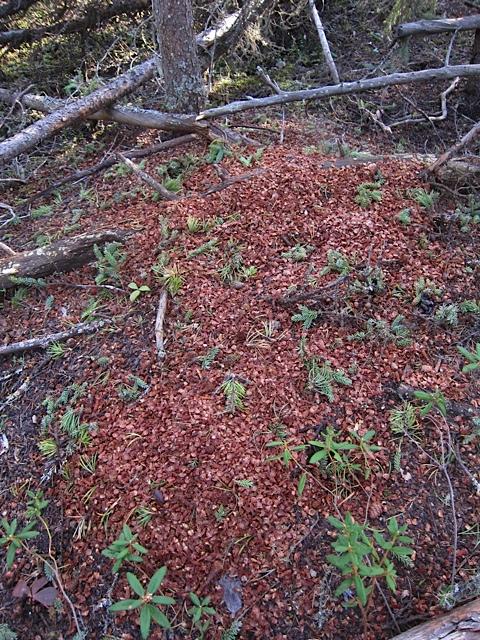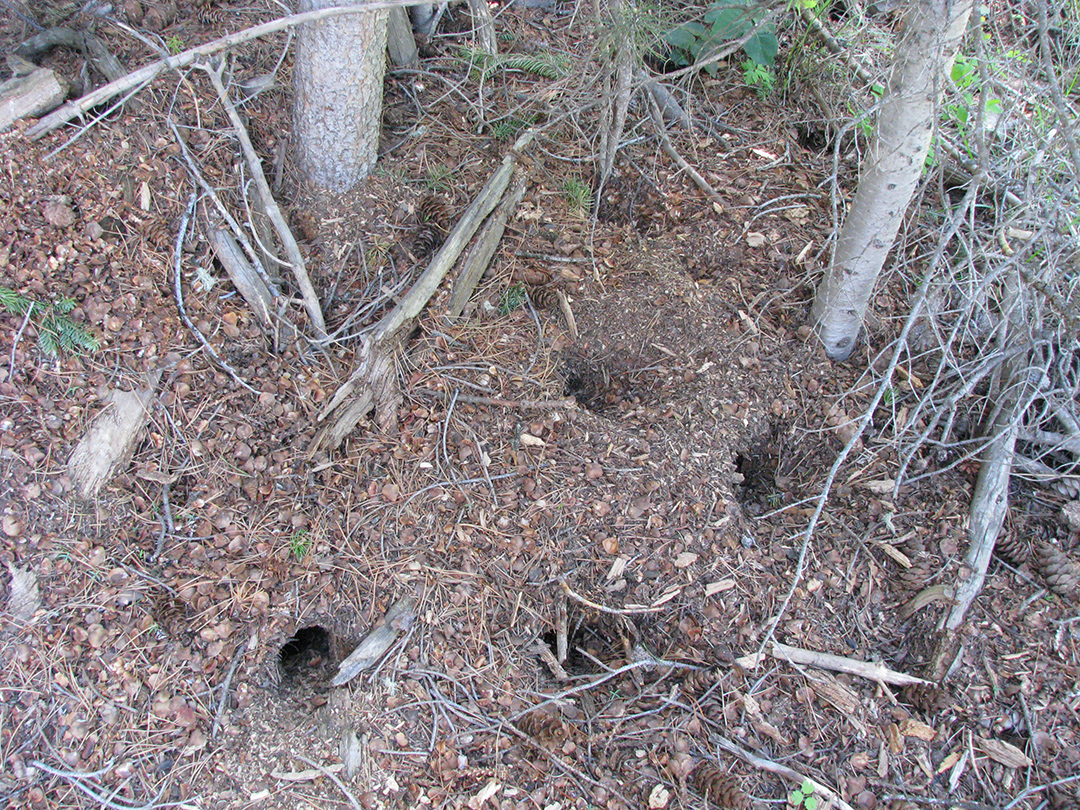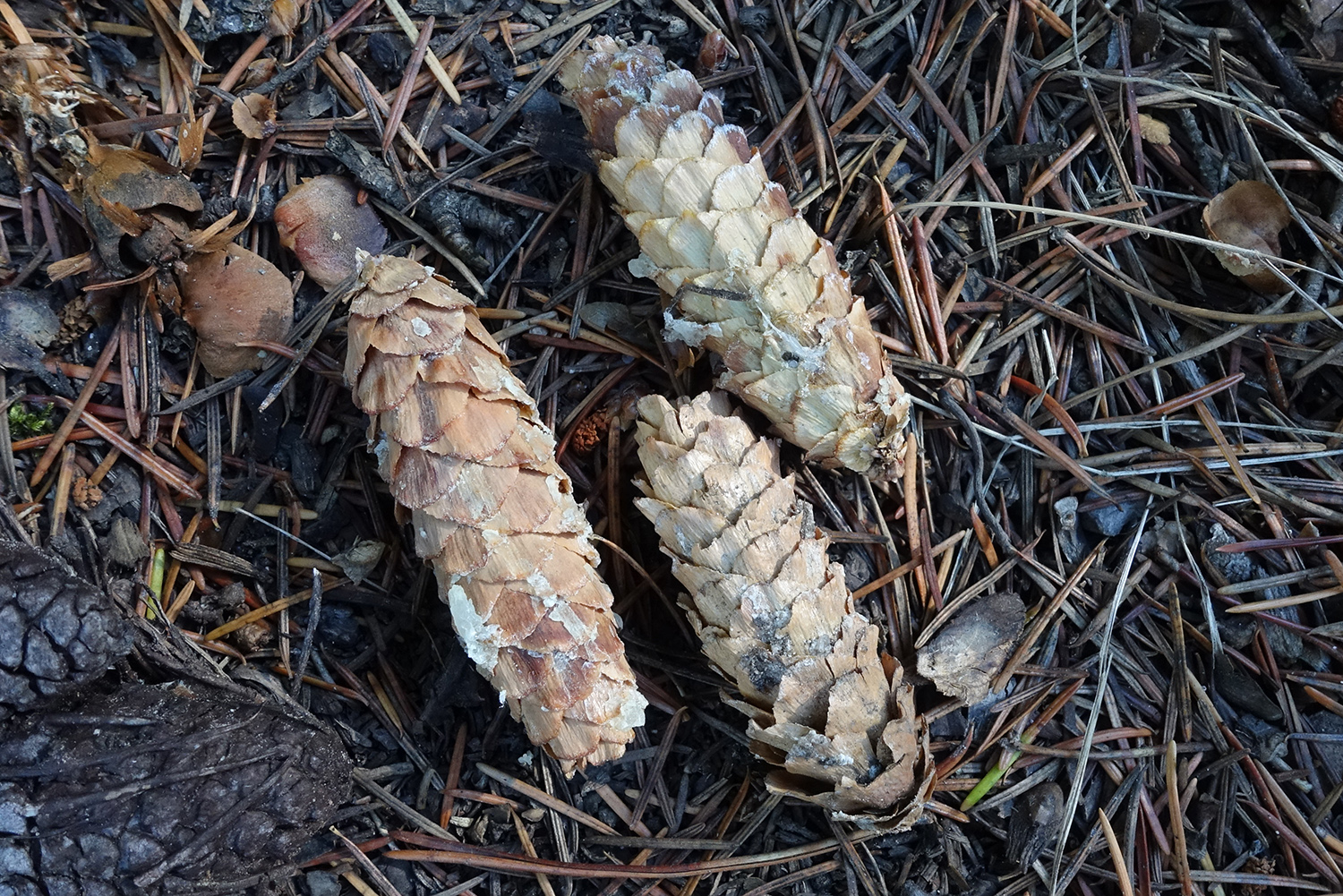By Frances Clark, Nature Mapper and Botanist
Hiking under Engelmann spruce trees has been hazardous this fall. Light brown cones, 4-6 inches long and sticky with pitch, pour down amidst harsh chattering from above. I have counted one cone falling every 3-5 seconds, another time I couldn’t keep track of the barrage. Cones landed on my head, bounced and then lay strewn about my feet. Cone storms. What s going on?
 Red squirrels are taking advantage of a “mast year.” Last spring, you may remember, prodigious amounts of pollen wafted on the wind. Some of that pollen landed on tiny female cones, which have matured, securing two winged seeds under each scale. Spruce trees are now laden with dangling cones from the top down. This abundance occurs every 2-3 years in spruce. The intervening times are lean.
Red squirrels are taking advantage of a “mast year.” Last spring, you may remember, prodigious amounts of pollen wafted on the wind. Some of that pollen landed on tiny female cones, which have matured, securing two winged seeds under each scale. Spruce trees are now laden with dangling cones from the top down. This abundance occurs every 2-3 years in spruce. The intervening times are lean.
Well adapted to feast and famine, red squirrels form large middens—stores of thousands of cones. They efficiently sample and then harvest trees with the most seed energy per cone and with the greatest cone abundance. Middens lie at the center of the most productive group of trees.
A midden can best be described as several inches of cone scales and cores heaped over mineral soil, forming mounds up to several feet high and wide. The loose surface often has shallow holes in it. In the mineral soil below, there may be a network of tunnels. Squirrels pack several cones, pointed end down, into holes which will be covered eventually by more scales and cores. In this cool and moist environment—a humidor—cones will remain unopened for at least 1-2 seasons until the squirrels retrieve them. When they do, squirrels eat cones like corn-on-the-cob, scattering scales everywhere while consuming the nutritious seeds. It has been calculated that squirrels consume 50-156 cones a day and stash 10s of 1000s in a midden in a good year. No wonder red squirrels are so territorial – chattering loudly at any perceived threat and dashing out to their territorial boundary: they are defending their stash for winter survival.

While cones are preferred, in lean times and in summer, red squirrels will eat other items. Fungi are particularly relished, with parts hung up in trees to dry. They eat buds, fruits, sap, even cambium and phloem, as well as eggs and insects. Small plant parts placed in middens may help train young squirrels for future hoarding. In different years, squirrels may harvest cones of Douglas firs – which have mast years every 4-5 years, or as back up, serotinous cones of lodgepole pine. Lodgepole pine cones are often gathered on top of middens. They do not open even when dry, are too tough for other predators to eat, and seeds remain viable for years. The squirrels don’t need to spend extra energy to bury them.

The other day, walking around Moose Ponds, I heard several red squirrels churring within a stand of battered old spruce and fir trees. Their density indicated good habitat. Tangles of downed limbs and saplings surrounded straight, scaly boles clad in densely needled branches, which intertwined to form a closed, irregular canopy. Engelmann Spruce reach peak production at 150-200 years and provide diverse cover, escape routes, and nesting sites. Old growth trees are excellent for red squirrels.
As red squirrels are active all winter, nesting sites are vital for thermal regulation. Tree squirrels prefer natural cavities, but these are often in short supply so instead squirrels will build a nest of leaves and grass 12 to 60 feet off the ground. Other options include “witches brooms,” an aberrant growth pattern where twigs are unusually dense. They will also burrow into tunnels under their middens for warmth and safety.
Nest sites are located within 100 feet of larders so squirrels can readily defend and retrieve their stores. Circular territories may be 1-2 acres centered around a midden. I nature mapped six squirrels – six territories – on my route past Moose Ponds. While dutiful, I wish now I had taken more time in this rough old patch of forest to see where the middens and nests might be.
Predators come from air or ground. Squirrels may have different calls depending on whether or not a threat is aerial or terrestrial. One study indicates that red squirrels produce a high frequency, short “seet” sound similar to alarm calls of birds. This sound is hard for raptors, such as Goshawk, Great Horned Owl, or Red-tail Hawk , to locate or even hear. A louder bark call is used for overland threats, such as a Pacific (pine) marten (12-20% of marten diet is red squirrels), weasels, or fox. Once alerted, squirrels scramble and hide in dense vegetation.
Between predation and starvation, only 25% of squirrels survive into their second year. Females are in estrus for one day only in early spring. Many males, one dominant in the lead, will give chase and several may succeed in copulation on that one day. In just over a month, the female gives birth to an average of four young which will be independent in another 70 days, by early fall. While mothers may share a territory with daughters, they kick out sons who must then find and defend their own territories by winter. Often the most successful males have ventured the farthest to find a relatively large territory containing an abandoned midden. Midden sites are often used by many generations. In autumn, youngsters and seasoned squirrels are particularly territorial, defending boundaries while gathering cones, which is why they are so vociferous.
Red Squirrels are the most frequently Nature Mapped small mammal with 305 observations over the last seven years. Even so, many of us pass them by – unrecorded – on our hikes. In your next excursions through a conifer forest, listen for chatter. Can you hear differences in their calls? Can you discover a midden nearby? Does a squirrel bound toward you to defend its territory or scurry up a tree or down into a tunnel to escape? Can you find its nest? All these behaviors are fascinating to watch while you may, or may not, log a new Nature Mapping observation.
References:
Animal Diversity Web ADW: Museum of Zoology University of Michigan. Tamiasciurus hudsonicus Red Squirrel. Accessed 10.8.16: http://animaldiversity.org/accounts/Tamiasciurus_hudsonicus/
Finley RB. Cone caches and middens of Tamiasciurus in the Rocky Mountain region. Misc. Publ. University of Kansas Museum Natural History. 1969;51: 233–273. https://archive.org/stream/cbarchive_36740_conecachesandmiddensoftamiasci1969/conecachesandmiddensoftamiasci1969 – page/n17/mode/2up
Greene E. Meagher T. 1998. “Red squirrels, Tamiasciurus hudsonicus, produce predator-class specific alarm calls.” Animal Behavior. 1998 Mar; 55(3): 511-8. Accessed through: https://www.ncbi.nlm.nih.gov/pubmed/9514668
Steele, M.A. 1998. “Tamiasciurus hudsonicus” Mammalian Species 586, pp. 1-9. : published by the American Society of Mammalogists. http://www.science.smith.edu/msi/pdf/i0076-3519-586-01-0001.pdf
Streubel, D. P. 1968. “Food storage and related behavior in red squirrels (Tamiasciurus hudsonicus) in Interior Alaska.” Masters Thesis. University of Alaska. Source: http://www.arlis.org/docs/vol2/hydropower/APA_DOC_no._3351.pdf
U.S. Forest Service data base: http://www.fs.fed.us/database/feis/animals/mammal/tahu/all.html
